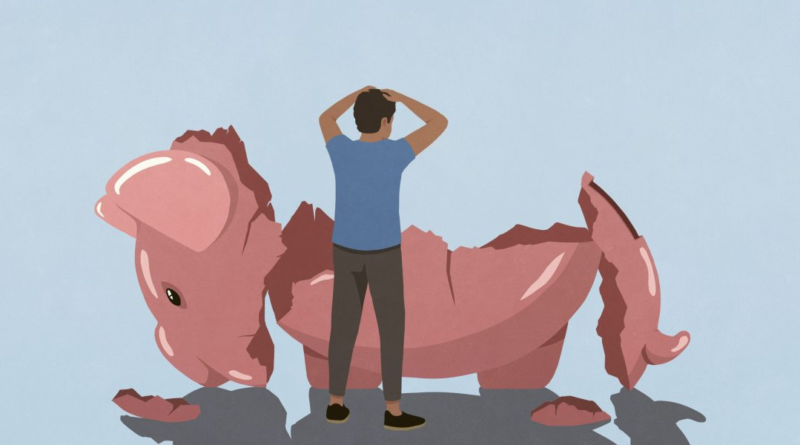'Phantom debt' from 'buy now, pay later' schemes is a $700 billion black hole that economists can't see a way around
Wall Street is generally convinced the economic health of the U.S. consumer is remarkably better than expected after COVID, but one analyst has pointed out there’s a gaping hole in the picture.
He calls it “phantom debt”—spending on “buy now, pay later” (BNPL) platforms, which often goes unrecorded by credit agencies.
Big bank CEOs have continually expressed their shock and delight at how well consumers are apparently faring.
JP Morgan Chase CEO Jamie Dimon recently said the consumer is in “pretty good shape” while the economy is “booming.”
Meanwhile, Bank of America CEO Brian Moynihan has encouraged Jerome Powell to be “mindful” of relying too heavily on consumers to prop up the economy, as they will eventually reach their breaking point.
While Citi CEO Jane Fraser has pointed out the “cracks” beginning to appear at the bottom end of the income ladder, a Wells Fargo analyst has also flagged a personal finance feature that is largely overlooked by the sector: people purchasing products—contributing to stronger sales for brands—but without paying the full balance at the time of sale.
Instead, payment for these products is taken in installments over a longer period of time—some of which come with service fees or with fluctuating repayment options depending on an individual’s perceived credit reliability.
The problem with this, for economists at least, is that the larger BNPL platforms often decline to share their customers’ purchasing patterns with some or all credit bureaus, concerned that their customers’ activity may ultimately bring down their credit score. Afterpay, for example, shares none of its data with credit agencies, while Klarna shares its data with U.K. credit bodies.
BNPL lenders may also report some but not all of their data. For example, in the U.K., BNPL providers are required to share a customer’s credit and repayment history for products with a short repayment window or multiple smaller payments across various accounts.
This black hole of information between BNPL lenders and credit agencies across the world is why Wells Fargo senior economist Tim Quinlan has coined the term “phantom debt,” per Bloomberg, saying experts have been “lulled into complacency about where consumers are” as a result.
“People need to be more awake to the risk of BNPL,” Quinlan added.
Of course, this isn’t just a problem for economists at banks taking a temperature check for the economy: it’s also a problem for policymakers who may not be seeing in the data individuals who are struggling, and are turning to BNPL services as a result.
These consumers, understandably, are among those concerned that using BNPL platforms will negatively impact their credit scores.
Experian told Fortune it already has the technology in place to ensure that doesn’t happen, a spokesman explained: “Experian has long supported the use of expanded data sources, including BNPL account information, to help consumers build their credit profile and improve their financial health. We have BNPL reporting mechanisms in place so providers can easily share account information, and prevent undue negative impact to an individual’s credit score.”
A $700 billion hole
This void of information isn’t a blip in consumer health—it represents hundreds of billions of dollars in consumer spending.
In 2024 alone, Juniper Research estimates, BNPL transactions will total $334 billion, ballooning to $687 billion by 2028, reflecting market growth of 105%.
Consumers are also becoming increasingly dependent on the platforms, with one in five customers using them to buy essential goods.
However, research by U.K. national charity Citizens Advice released in November found that 21% of BNPL customers have either missed or made a late payment, with 10% saying they had been visited by an enforcement agency or bailiffs.
Moreover, nearly a third of BNPL customers who had paid an installment within a month of completing the survey had borrowed the money from another lender—compounding debt with yet more debt.
The Federal Bank of New York has also warned that the people using BNPL services are “disproportionately” financially fragile—as measured by the average likelihood of being able to come up with $2,000 in the next month in case of an emergency.
This “raises questions about the resilience of BNPL lending and its performance following an adverse economic shock,” researchers Felix Aidala, Daniel Mangrum, and Wilbert van der Klaauw added in the September note.
For their part, some of the largest players in the BNPL space are actually calling for better oversight in the U.S.
In March, Klarna called for rules “under the umbrella of new and proportionate regulation” and in a further statement to Fortune, added: “Right now Klarna does not report positive or negative information to the US credit bureaus. We have supported the principle of sharing data with the bureaus for some time as a way to help providers make better lending decisions and to ensure the financial safety and protection of consumers.
“Unfortunately, the current models the bureaus are using or creating still cannot ensure responsible BNPL usage is calculated in credit scoring and we believe a model needs to be developed that works for different forms of credit.”
Klarna was echoed by competitor Clearpay—part of the Afterpay group—which told Fortune “there is not a solution developed for the innovation BNPL has brought to the sector.”
A spokesman for the company added: “We look forward to seeing specific plans from credit bureaus about how they would like to incorporate customer BNPL information into their reports—in a way that is reflective of how customers use this service to help manage their spending. Customer data is of the utmost importance to us, and any changes to the way our product works or the policies we have in place to protect our customers and their data will need to be proven and reviewed carefully.”




